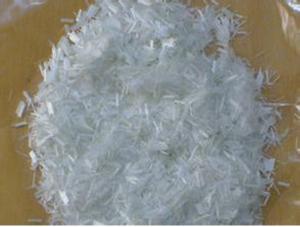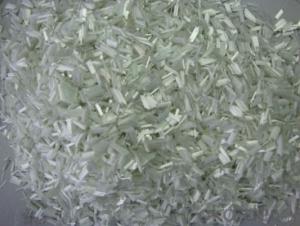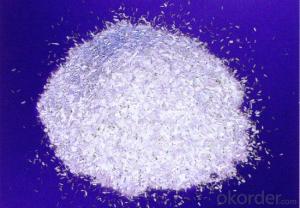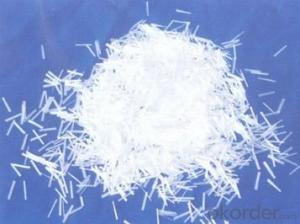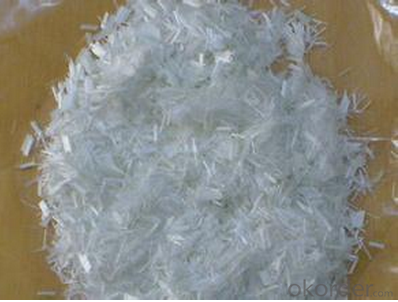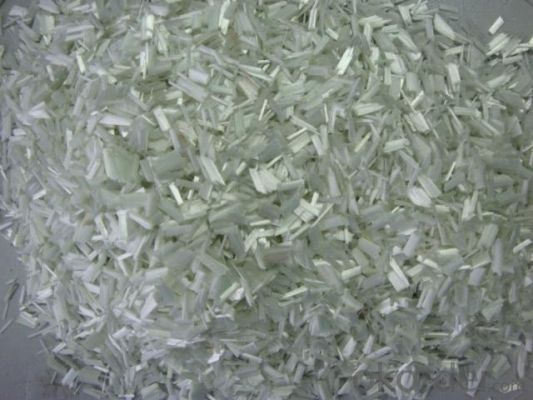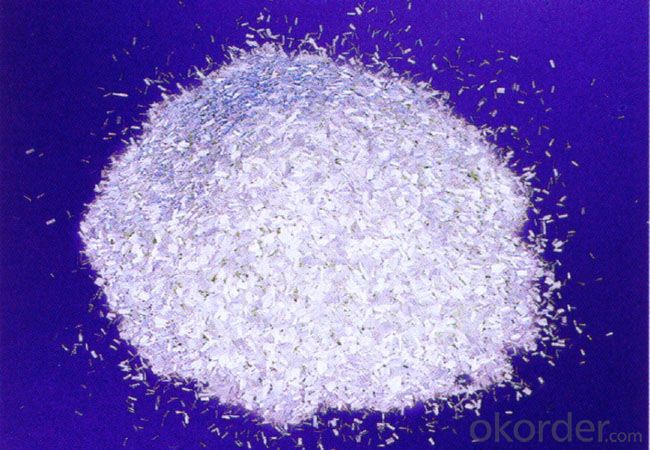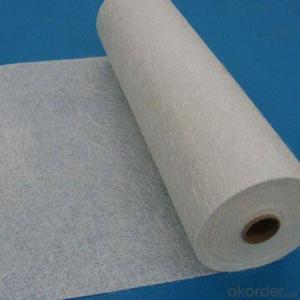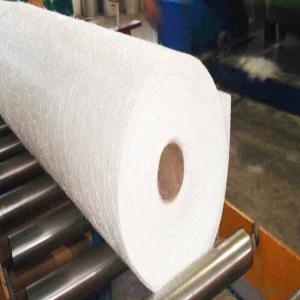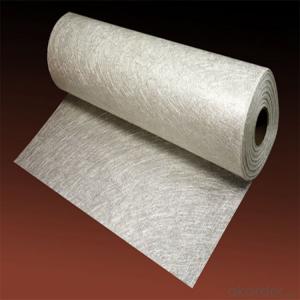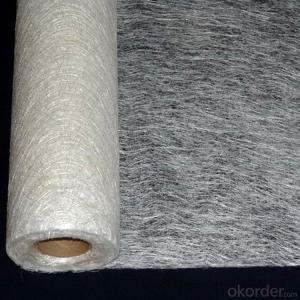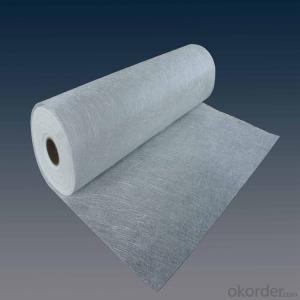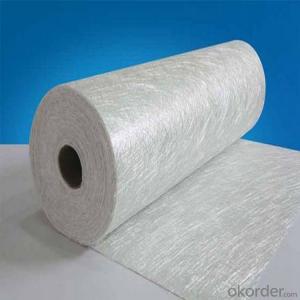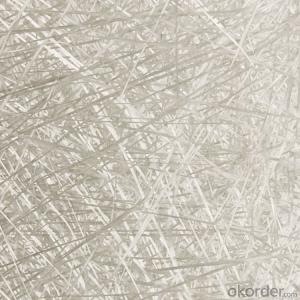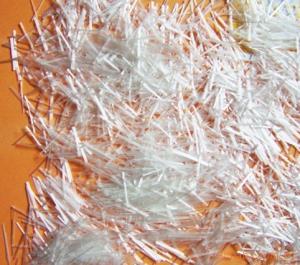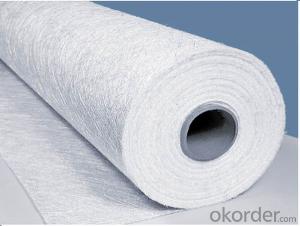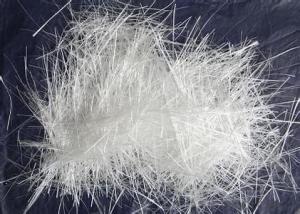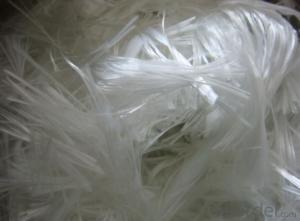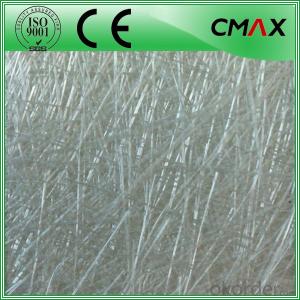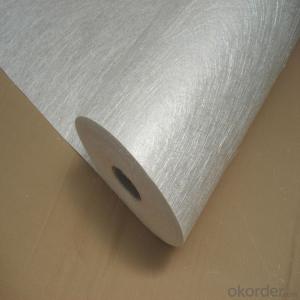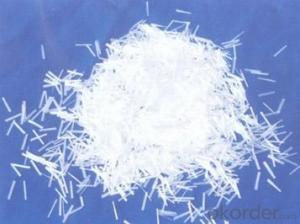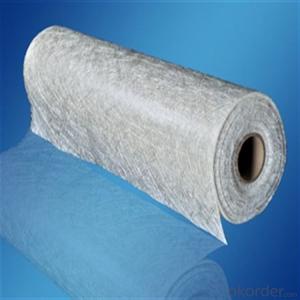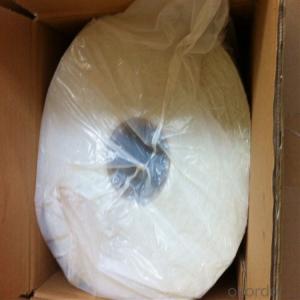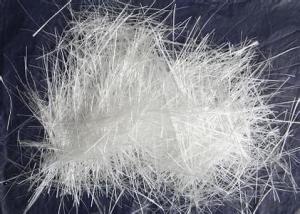E-glass Fiber Chopped Strands Produced By Wet Method
- Loading Port:
- Shanghai
- Payment Terms:
- TT or LC
- Min Order Qty:
- 20000 kg
- Supply Capability:
- 200000 kg/month
OKorder Service Pledge
OKorder Financial Service
You Might Also Like
Description:
E Glass Fiber Chopped Strands Produced By Wet Method are compatible with unsaturated polyester, epoxy and phenolic resins and gypsum.
Wet Chopped Strands have moderate moisture content and deliver outstanding flowability, including dispersion in water and in gypsum.
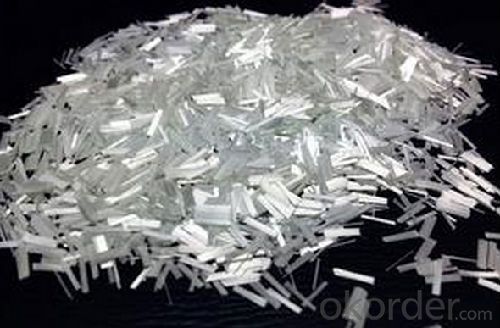
Product Features:
Excellent dispersion in water
Good bonding with multiple resins
Outstanding tensile and tear properties in the final product
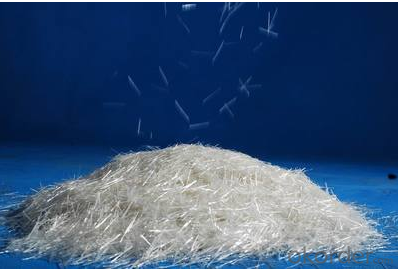
Product Specifications:
Property | Fibre diameter | Moisture Content | Size Content | Chop |
(%) | (%) | (%) | (%) | |
Mathods | IS01888 | ISO3344 | ISO1887 | |
3mm | ±10 | ≤3.0 | 0.1±0.05 | 98 |
6mm | ||||
12mm | ||||
18mm |
Special specification can be produce according to customer requirements.
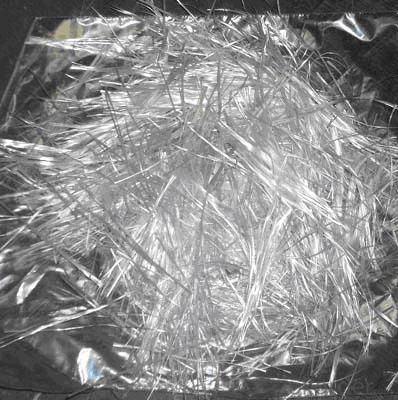
Packaging:
Each bag can be taken (15-25kgs)。 Could also take a big container bag.
Storage:
Unless otherwise specified, It should be stored in a dry, cool and rain-proof area. It is recommended that the room temperature and humidity should be always maintained at 15℃~35℃ and 35%~65% respectively.
FAQ:
1..Is your company a factory or trade company?
A:We have our own factory , we are on this business more than 10 years.
2.Who will pay for the express cost ?
A: We can support you free samples ,but express cost will be paid by you .
3.How long is the delivery time?
A:within 10-15 days after receiving deposit.
- Q: Is fiberglass chopped strand compatible with different coating methods?
- Yes, fiberglass chopped strand is compatible with different coating methods. It can be used with various coating techniques such as spray-up, hand lay-up, and filament winding, making it a versatile option for different applications and industries.
- Q: Can fiberglass chopped strand be used in the production of decorative items?
- Yes, fiberglass chopped strand can be used in the production of decorative items. Fiberglass chopped strand is a versatile material that can be easily molded into various shapes and sizes, making it ideal for creating decorative items. It is commonly used in the production of decorative objects such as figurines, sculptures, vases, and other aesthetically pleasing items. The chopped strand can be mixed with a resin or binder, and then molded or cast into the desired shape. It offers excellent strength and durability, making it suitable for long-lasting decorative pieces. Additionally, fiberglass chopped strand can be easily colored or painted, allowing for endless design possibilities. Overall, fiberglass chopped strand is a popular choice for manufacturers looking to produce decorative items that are not only visually appealing but also strong and durable.
- Q: What are the weathering resistance properties of fiberglass chopped strand?
- Fiberglass chopped strand exhibits excellent weathering resistance properties due to its inherent resistance to UV radiation, moisture, and temperature variations. This material is highly durable and can withstand prolonged exposure to outdoor elements without significant degradation or loss of performance.
- Q: Can fiberglass chopped strand be used for reinforcing concrete?
- Yes, fiberglass chopped strand can be used for reinforcing concrete. Fiberglass chopped strand is a type of reinforcement made from strands of glass fibers that are chopped into short lengths and added to the concrete mixture. These fibers enhance the overall strength, durability, and crack resistance of the concrete. They also help to control shrinkage and reduce the formation of cracks. Fiberglass chopped strand is lightweight, corrosion-resistant, and offers excellent performance in harsh environments. It is commonly used in applications such as concrete slabs, walls, precast elements, and shotcrete.
- Q: What are the acoustic properties of fiberglass chopped strand?
- Fiberglass chopped strand has several acoustic properties that make it a popular material in various applications. Firstly, it has excellent sound absorption capabilities due to its fibrous structure. The random orientation of the chopped strands creates spaces and voids that effectively trap and dissipate sound energy, reducing echo and reverberation in enclosed spaces. Additionally, fiberglass chopped strand exhibits low density, making it a lightweight material with good sound insulation properties. It can effectively block and reduce the transmission of sound waves, making it suitable for applications where noise control is important, such as in building construction or automotive interiors. Moreover, fiberglass chopped strand is known for its high tensile strength and durability, which contributes to its acoustic performance. Its strong and resilient nature allows it to maintain its sound-absorbing and insulating properties over time, even in demanding environments. Another advantage of fiberglass chopped strand is its versatility in terms of customization. It can be manufactured with varying thicknesses and densities to meet specific acoustic requirements. This flexibility allows it to be tailored for different applications, such as in soundproofing panels, acoustic ceiling tiles, or speaker enclosures. Lastly, fiberglass chopped strand is non-combustible and resistant to moisture, mold, and mildew. These properties make it suitable for use in areas where fire safety and moisture resistance are critical, such as in theaters, recording studios, or industrial settings. Overall, the acoustic properties of fiberglass chopped strand, including its sound absorption, insulation, strength, customization options, and resistance to fire and moisture, make it a favored material for a wide range of applications where sound control and quality are important.
- Q: How does the curing time of fiberglass chopped strand-reinforced composites compare to other reinforcing materials?
- The curing time of fiberglass chopped strand-reinforced composites is generally shorter compared to other reinforcing materials. This is due to the unique properties of fiberglass, such as its ability to conduct heat more efficiently and its faster reaction to curing agents. In comparison to other reinforcing materials like carbon fiber or Kevlar, fiberglass composites tend to cure faster. This is beneficial in various industries where time efficiency is crucial, such as automotive, aerospace, and construction. The shorter curing time allows for quicker production cycles and faster turnaround times. However, it is important to note that the curing time can vary depending on the specific resin system used, the thickness of the composite, and the curing conditions. Different resin systems and composite configurations may require longer or shorter curing times to achieve optimal strength and performance. Overall, fiberglass chopped strand-reinforced composites offer a distinct advantage in terms of curing time when compared to other reinforcing materials, making them a preferred choice in many applications.
- Q: Can fiberglass chopped strand be used in aerospace composites?
- Yes, fiberglass chopped strand can be used in aerospace composites. Fiberglass chopped strand is a common reinforcement material that is widely used in various industries, including aerospace. It offers excellent strength-to-weight ratio, chemical resistance, and thermal stability, making it suitable for aerospace applications where lightweight and high-performance materials are required. Fiberglass chopped strand can be used in the production of aerospace components such as panels, fairings, interior parts, and structural elements. It can be combined with other reinforcement materials, such as carbon fibers, to enhance the overall properties of the composite. However, it is important to note that the specific requirements and regulations of each aerospace project should be considered when selecting the appropriate reinforcement material.
- Q: How does the color of the chopped strand affect its performance?
- There are several ways in which the performance of chopped strand can be influenced by its color. Primarily, the color can serve as an indicator of the type of resin or binder utilized to bind the strands together. Different resins possess distinct properties that can impact the strength, flexibility, and overall performance of the chopped strand. Furthermore, the color of the chopped strand can also have an effect on its adhesion properties. Certain colors may exhibit superior adhesion to specific materials or substrates, while others may not adhere as well. This can significantly impact the overall durability and strength of the final product. Additionally, the color of the chopped strand can also play a role in its resistance to UV degradation. Certain colors may possess a higher level of resistance, which is particularly crucial in applications where the material will be exposed to sunlight or outdoor conditions. This resistance helps to prevent the material from becoming brittle or discolored over time. Lastly, the color of the chopped strand can also contribute to its aesthetic appeal. In applications where appearance is of importance, such as in automotive or consumer products, the color of the chopped strand can greatly enhance the visual appeal of the finished product. To summarize, the color of chopped strand can impact its performance by influencing the type of resin used, adhesion properties, resistance to UV degradation, and aesthetic appeal. It is imperative to consider these factors when selecting chopped strand for a particular application in order to ensure optimal performance and desired results.
- Q: How is the water absorption of fiberglass chopped strand determined?
- The water absorption of fiberglass chopped strand is determined through a test called the water absorption test. In this test, a sample of the fiberglass chopped strand is weighed and then immersed in water for a specific period of time. After the immersion, the sample is removed from the water, any excess water is gently removed from the surface, and the sample is re-weighed. The difference in weight before and after immersion is used to calculate the water absorption of the fiberglass chopped strand. This measurement provides valuable information about the material's ability to resist water penetration and its overall durability.
- Q: What are the typical flexural strength values of chopped strand composites?
- The flexural strength values of chopped strand composites can differ based on various factors, such as the type of resin matrix, fiber content, fiber orientation, and manufacturing process. Typically, chopped strand composites exhibit flexural strength values ranging from 100 MPa to 400 MPa (14,500 psi to 58,000 psi). In terms of its ability to resist bending or deformation under a load, the flexural strength of a chopped strand composite is crucial in applications where the material experiences bending or flexing forces, like in structural components or automotive parts. The specific flexural strength values can be influenced by the type of fibers utilized, such as glass, carbon, or natural fibers. Glass fibers are commonly used and typically provide a flexural strength ranging from 100 MPa to 200 MPa (14,500 psi to 29,000 psi). On the other hand, carbon fibers offer higher flexural strength values, typically ranging from 200 MPa to 400 MPa (29,000 psi to 58,000 psi), making them suitable for applications requiring high strength and stiffness. It is crucial to note that the actual flexural strength values of chopped strand composites can significantly vary based on the aforementioned factors and manufacturing techniques. Therefore, it is recommended to consult specific material datasheets or conduct testing to determine the precise flexural strength values for a particular chopped strand composite.
Send your message to us
E-glass Fiber Chopped Strands Produced By Wet Method
- Loading Port:
- Shanghai
- Payment Terms:
- TT or LC
- Min Order Qty:
- 20000 kg
- Supply Capability:
- 200000 kg/month
OKorder Service Pledge
OKorder Financial Service
Similar products
Hot products
Hot Searches
Related keywords
